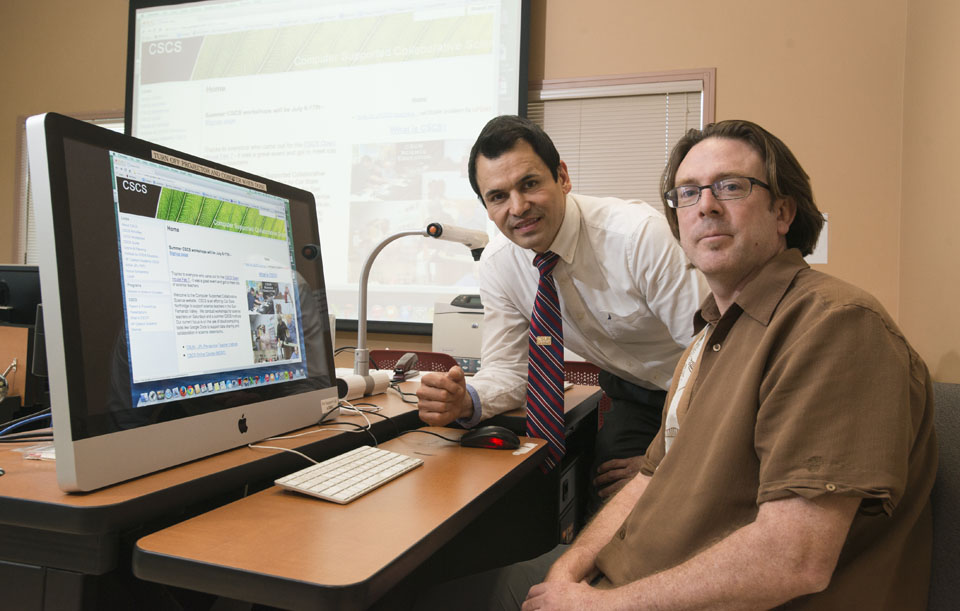Bechtel Grant Provides CSUN Profs New Look at Tech in the Classroom
Reading from a science textbook alone will not adequately prepare the next generation of citizenry with needed 21st century skills according to two California State University, Northridge professors. Thanks to being awarded part of a $3 million grant from the S. D. Bechtel, Jr. Foundation, newer and more effective teaching methods can be tested out by education professors Brian Foley and John M. Reveles.
The S. D. Bechtel, Jr. Foundation supports education programs throughout the state, including efforts of teacher preparation programs to transition to the new Common Core and Next Generation Standards.
Using technology as the foundation for their research model, Foley and Reveles anticipate showing how the use of technology tools in the classroom can make learning about science more engaging and educationally relevant.
“Let’s face it, technology is ubiquitous,” Reveles said. “It permeates society. Students are tech savvy. It’s trying to get teachers on board, not to change practice but to enhance their lessons through the use of technology that is important for us. It’s really supporting good teaching. The computers can support and enhance that.”
Foley and Reveles explained that using Google docs and other technology-based tools in the classroom would enhance the learning experience for both teachers and students by creating real-time collaboration on a project or assignment.
“The work is in real time, you can formatively assess your students on a real-time basis,” Reveles explained.
Foley said the teaching method easily aligns with Next Generation Science Standards (NGSS), which call for more collaborative work in the classroom.
“It supports what NGSS and Common Core State Standards will expect teachers to do. You can support lots of writing with collaborative documents,” Foley said. “Talk about data pooling. If you are doing an experiment in the classroom, students can see bigger trends, can see some places where they can really try and figure out what it means when data is pooled together.”
A co-investigator in the project is CSUN secondary education professor Ivan Cheng who is assisting Foley and Reveles through the use of a collaborative teaching model where teachers will meet to discuss how to create and improve lesson activities for their students, called the Responsive Teaching Cycle (RTC).
Reveles said that working with Cheng has expanded what their technology-based lesson activities can provide for teachers as well.
“That symbiotic relationship is what we entered with Ivan when we started talking about submitting this grant. There are a lot of interconnections here,” he said.
Through two projects, the Computer Supported Collaborative Science (CSCS) and RTC, the New Generation of Educators project funded through the grant allows us to combine both of them to support new teachers. That’s the idea with the New Generation of Educators grant, we can support teaching practices in math and science and eventually in all subjects. That’s our vision. I believe in what we are doing.”
The project, with research analytics and data pooling and sampling by CSUN professor and researcher Andrew Ainsworth and his Center for Assessment Research and Evaluation (CARE) team, will begin with an upcoming three-week summer training session for teachers from the San Fernando Valley area. Local middle school students and in-service teachers will experience collaborative science and teaching practice preparation during the summer institute which gives them the chance to serve as mentors for science and math student teachers from CSUN’s Michael D. Eisner College of Education during the Fall 2015 semester.
“By pairing experienced in-service teachers with pre-service student teachers who receive [our] training, both parties will be better prepared for the new science and core state standards,” Reveles said. “We want to mentor and teach faculty as well as student teachers. One of the key elements for changing the way we prepare the next generation of teachers is to change not only what teachers experience at the university, but the way they utilize and practice that prep in the classroom. So, by training in service and pre-service teachers and linking those two up, then we can really change the way they do business in the classroom.”
Foley agreed that being able to link both groups allows for everyone to be on the same page when learning how to navigate technology use in the classroom, especially with the summer program as practice time.
“Teachers need practice teaching with technology with real students, instead of telling them how to use technology, we provide a class where they are forced to try it. So we give them a few days to get used to the idea,” he said. “We’ve designed a curriculum with fun science activities where [students and teachers] are using collaborative technology so teachers see how it works. I think we’ve seen that they learn a lot and teachers have realized what students can do instead of just what the teacher tells them to do.
“There’s a misconception that if you bring computers into the classroom, you don’t do hands-on science. That would be terrible, we love hands-on science. Our project is built around how the computer supports scientific inquiry and having students make sense of the data.”
For Reveles, being able to provide an opportunity for better learning is paving the way for more effective teaching and learning outcomes.
“We are trying to make these approaches accessible to teachers and students who might not otherwise have had the opportunity for collaborative learning before,” he said. “We’re being revolutionary. You show them the possibility and you give them the tools. The rest is up to them.”


 experience
experience